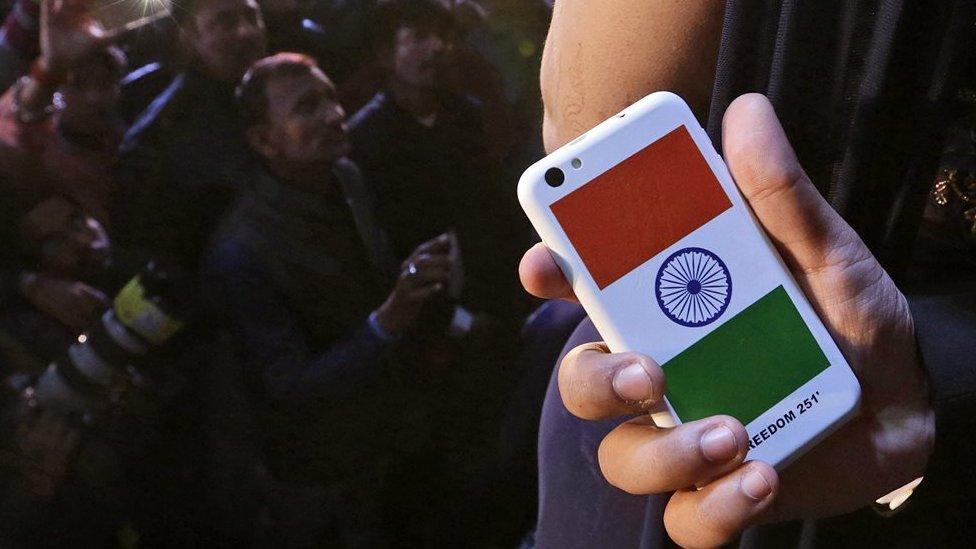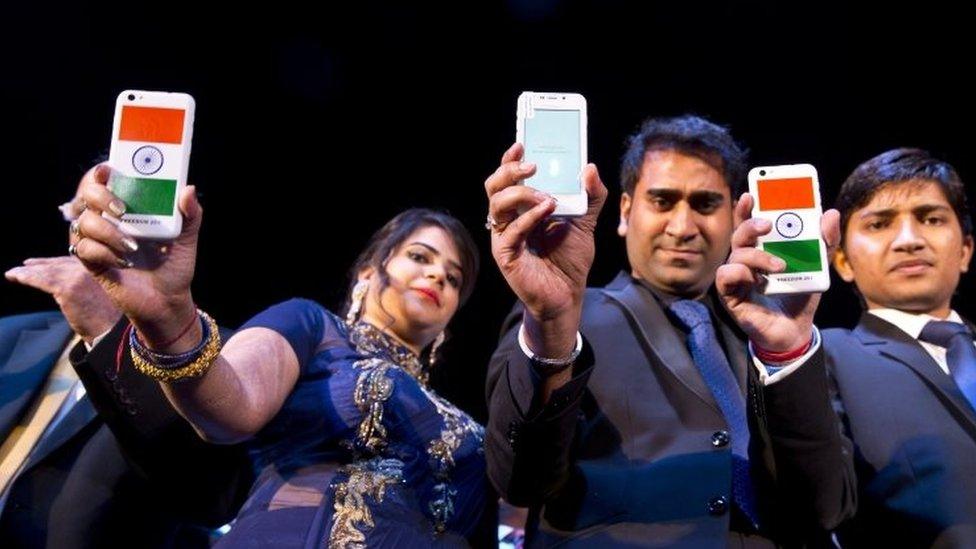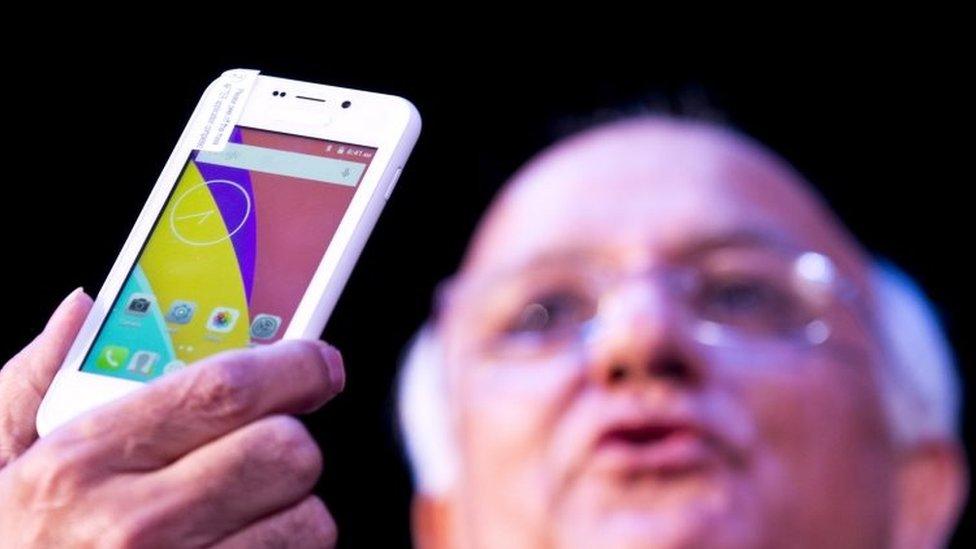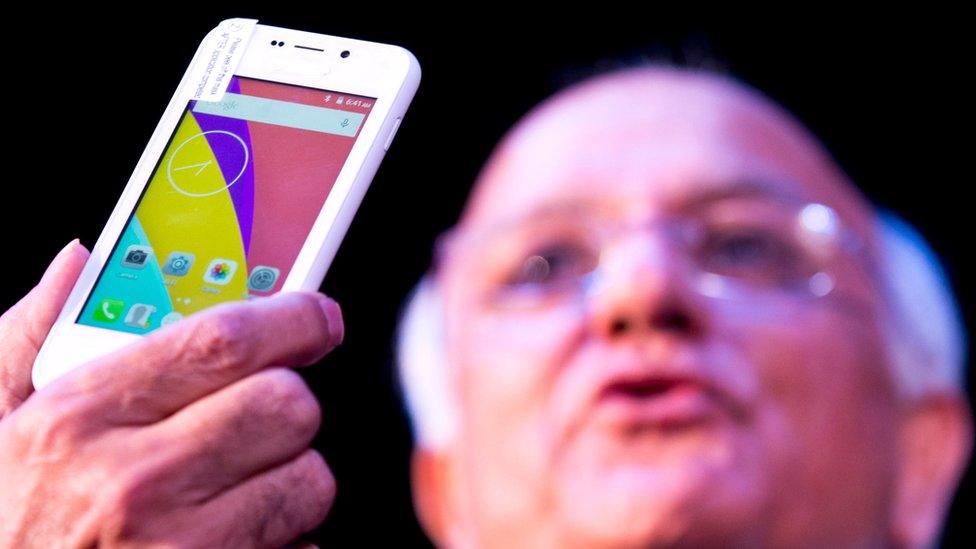Is India’s $3.60 smartphone too good to be true?
- Published

Freedom 251's specifications are similar to phones at least 15 times more expensive
On Wednesday evening a virtually unknown Indian company launched the "world's cheapest smartphone", named Freedom 251, for 251 rupees ($3.60; £2.50), in Delhi.
The handset, from Ringing Bells, external, a company less than a year old and based in Noida near the capital, Delhi, is a 3G smartphone with specifications similar to phones at least 15 times more expensive.
On Thursday, it opened its website freedom251.com, external for pre-orders with payments due in full in advance - the phone would be sold online over a five-day window. Deliveries are promised by June.
The website crashed, and it put up a notice claiming overwhelming response at "600,000 hits per second", due to which it was pausing bookings for a day. The company's office was also swamped by thousands of potential buyers.
The firm's founder, Mohit Goel, said the phone would be locally made as part of the "Make in India" program promoted aggressively by Prime Minister Narendra Modi's government.
However, the prototypes shown to media were of a Chinese-made phone with its brand name, Adcom, covered with white paint. The Android-based smartphone, with a 4-inch display, looks very similar to Apple's older iPhone 4 handset, complete with a home button and icons that are nearly identical to the iPhone's.

Senior BJP MP Murli Manohar Joshi launched the phone
Adcom is a Delhi-based importer of technology products. Its Ikon 4 handset, available for 4,000 rupees (about $59; £41) on Indian e-commerce site Flipkart, appears to be very similar in specifications to Freedom 251. However, the Hindustan Times newspaper quoted Adcom's marketing head denying any knowledge of the company being associated with the Freedom 251 handset.
Experts who tried out the samples said the experience, including the 480×800 display and performance, was as expected for an entry-level phone in the $50 range: usable, not great. As is the norm in mid-range phones sold in India, slots for a memory card and two SIM cards have been provided.
Meanwhile, according to media reports, the Indian Cellular Association has written to telecoms minister Ravi Shankar Prasad saying it was not possible to sell a 3G phone below 2,700 rupees.
A member of parliament from the ruling Bharatiya Janata Party, Kirit Somaiya, went further in his letter to the minister, saying this could be a "Ponzi scheme" or other scam.
How is it so cheap?
At this price, the phone is clearly being subsidised. The company denies any government subsidy or involvement, and says that economies of scale will ultimately help it meet the low selling price.
However, industry experts familiar with telecom manufacturing say that the handset's cost of components alone adds up to over eight times its selling price, not counting production, distribution and marketing costs. That suggests an over 90% loss being absorbed somehow.

Ringing Bells will also likely pick up a lot of cash from advance bookings, with deliveries promised four months later
Datawind CEO Suneet Singh Tuli, whose company supplied the low-priced Aakash tablet computer to India's government during the former Congress party-led government, says the cost of their components alone is eight times the price it's selling at.
"And commodities like memory have a determined global price that exceeds 251 rupees, so economies of scale will never reach 251 rupees."
So how will Ringing Bells continue, without any external subsidy? It might, say analysts, launch some handsets later that would be overpriced, to compensate.
Will it work?
In 2015, 94% of feature-phones (as opposed to smartphones) sold in India were priced below 2,000 rupees ($30; £21), according to data from analyst firm CyberMedia Research (CMR). So clearly there is a huge market in India for very low cost feature-phones.
Smartphones, on the other hand, saw a huge spread in prices. But the top selling category, accounting for over 22% of smartphones sold in India in 2015, were for 4,000 to 6,000 rupees - rather than in the cheapest price range for smartphones, which starts below 3,000 rupees. So cheapest isn't the bestseller for smartphones.

The firm has denied that it's getting subsidy from the government
But that's with normal pricing and "you get what you pay for" market economics. That can change with an aggressively subsidised model. If buyers see this as a $60 model that is being discounted by 90%, they will flock to it.
"The biggest challenge then would be to manage the scale," CMR analyst Faisal Kawoosa says.
"This is a new entrant with no evident electronics background, so it won't be easy."
He adds that the company does not appear to have a registration that is mandatory for phones sold in India.
The Indian government website does show a registration for 'Freedom' phones made by a Chinese firm, Shenzhen HSEM, though.
For Freedom 251's vendor, there may be learning from at least three other products.
One, the world's cheapest car, the Tata Nano, created a global sensation when it was launched in 2009 at 100,000 rupees (less than $1,500 today, or $2,000 in 2009), but market response was underwhelming, and seven years later the Nano isn't even in the top 10 cars sold in India.
Reliability and supply issues were part of the problem, besides which the Nano's price has more than doubled since its launch.

The firm wants to capture the low-end smartphone market in India
Only three of India's top 10 cars, by unit sales in 2015, were low-priced, entry-level models.
The second is Apple. With its top-end iPhones failing to sell in the price-sensitive Indian market, it adopted the strategy of selling old iPhone models at low prices. As of today, it continues to sell the five-year-old iPhone 4s for about $150.
It did not work. Indian buyers appeared to reject the "old phones cheap" strategy, and Apple retains an incredibly low 1% of India's smartphone market.
And finally, the Aakash, billed as the world's cheapest tablet computer, a project backed strongly by the UPA government. At first severely criticised for its poor specifications, it was then upgraded.
Aakash 2, launched in 2012 by India's president Pranab Mukherjee, was to be sold to college students at a remarkably low price of 1,130 rupees (then $21, £13), thanks to a waiver of duties and a 50% subsidy.
But due to differences within the government, long decision cycles, supply issues, and finally the change of regime in 2014, the project was dropped.
Its supplier, however, sold the Aakash tablet under its own UbiSlate brand for about $78, and high buyer interest propelled it to the list of top five tablet vendors in India, where it has for company only one other non-Indian brand, Samsung (Apple's iPad has low market share in India).
Datawind now sells over 15 tablet models at Ubislate.com, priced between $50 and $150, and says it has sold over 2.5 million units since 2012.
"India's tablet market in 2011 was only 250,000 units," Datawind's CEO Tuli says. "An affordable product helped the market grow 20-fold."
- Published18 February 2016
